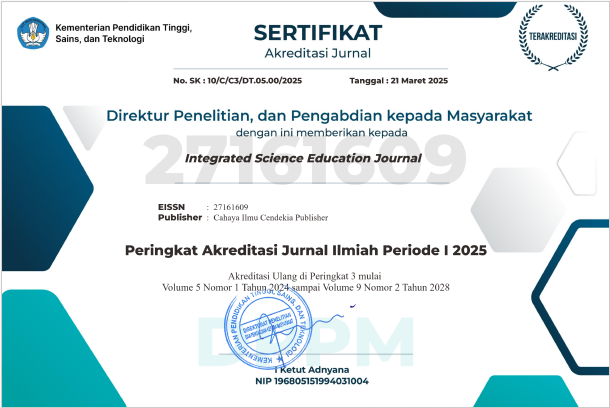Learning Outcomes for Students Junior High School: Entrepreneurship-Based Learning Video
Abstract
Purpose of the study: This study aims to develop entrepreneurship-based learning video media on environmental pollution material and its application in science learning in junior high school.
Methodology: This research is classified as research and development using the ADDIE model, which consists of the stages of analysis, design, development, implementation, and evaluation. The subjects used were 24 students and 2 teachers to see responses to entrepreneurship-based learning videos using purposive sampling. Data analysis used descriptive statistics (Category, Min, and Max) and inferential (One paired t-test).
Main findings: In this study, the results of validation by material experts and validation by media experts were very feasible. The results of the science teacher's responses and student trials in one-on-one, small, and large group trials were obtained in the very good category. And there are significant differences for students in using Entrepreneurship-based learning videos
Novelty/Originality of this study: In the era of the industrial revolution and social revolution, human resources are needed to go through this. Therefore, especially in junior high schools, teachers must carry out innovations, one of which is to innovate in the learning media used, namely using entrepreneurship-based learning videos. Today's students must have an entrepreneurial spirit or attitude to compete in the present.
References
A. Djamaludin., and W. Wardana, Belajar dan Pembelajaran 4 Pilar Peningkatan Kompetensi Pedagogis, Sulawesi Selatan: CV Kaaffah Learning Center, 2019.
M. Mahirullah, S. M. Husna, and F. Adriani, “Analysis of the Application and Correlation of the Murder Type Collaborative Learning Model on Student Learning Outcomes at Senior High School Jambi,” Jor. Eva. Edu, vol. 4, no. 1, pp. 21-30, 2023.
R. Fitriani, L. Anatri, O. S. Joint, and R. Risnita, “Scope of Learning Evaluation in Science Subject in Junior High School Students: A Systematic Review”, Jor. Eva. Edu, vol. 4, no. 1, pp. 08-16, 2023.
H. Batubara, “Media Pembelajaran Efektif”, Semarang: Fatawa Publishing, 2020.
Ramadhanti, “Literature Study: Application of Positive Psychology to the Field of Education in Indonesia,” Jor. Eva. Edu, vol. 4, no. 2, pp. 62-67, 2023.
D. D. Panggabean., and I. Ramadhani, Pembuatan Media Video Pembelajaran Fisika SMA Dengan Whiteboard Animation, Media Sains Indonesia, 2021.
S. Aswara, F. D. Amanda, and R. Fitriani, “Pengaruh Media Pembelajaran Fisika Berbasis Video untuk Meningkatkan Minat dan Pemahaman Konsep Materi Tekanan Siswa SMAN 2 Sungai Penuh,” In. Sci. Ed. J, vol. 3, no. 1, pp. 16-23, 2022.
F. Apriliyani, “Identifikasi Motivasi Siswa Sekolah Dasar Menggunakan Video Animasi Tentang Sumber Daya Alam,” In. Sci. Ed. J, vol. 1, no. 1, pp. 23-29, 2020.
R. Mutia., A. Adlim., and A. Halim, “Pengembangan video pembelajaran IPA pada materi pencemaran dan kerusakan lingkungan,” Jurnal Pendidikan Sains Indonesia, vol. 5, no. 2, pp. 108-114, 2017.
I. W. Iwantara., I. W. Sadia., and K. Suma, “Pengaruh penggunaan media video youtube dalam pembelajaran IPA terhadap motivasi belajar dan pemahaman konsep siswa,” Jurnal Pendidikan Dan Pembelajaran IPA Indonesia, vol. 4, no. 1, 2014.
D. Yunita., and A. Wijayanti, “Pengaruh media video pembelajaran terhadap hasil belajar IPA ditinjau dari keaktifan siswa,” Sosiohumaniora: Jurnal Ilmiah Ilmu Sosial Dan Humaniora, vol. 3, no. 2, 2017.
H. Van der Meij., and J. Van Der Meij, “A comparison of paper-based and video tutorials for software learning,” Computers & education, vol. 78, pp. 150-159, 2014.
M. Irsyad., T. Abas., and A. Ana, “Perancangan Media Video Tutorial Kerajinan Kruistik Untuk Peserta Didik SMP Terbuka Lembang 3,” FamilyEdu: Jurnal Pendidikan Kesejahteraan Keluarga, vol. 4, no. 2, pp. 93-102, 2017.
R. M. Branch, Instructional design: The ADDIE approach, New York: Springer, 2009.
M. Rusdi. Penelitian Desain dan Pengembangan Kependidikan. Rajawali Pers. Jakarta: PT Raja Grafindo Persada, 2018.
N. Suryani., A. Setiawan, and A. Putria, Media Pembelajaran Inovatif dan Pengembangannya. Bandung: PT. Remaja Rosdakarya, 2018
J. W. Creswell, A concise introduction to mixed methods research. SAGE publications, 2014.
H. Muhammad., R. E. Murtinugraha., and S. Musalamah, “Pengembangan media pembelajaran e-learning berbasis moodle pada mata kuliah metodologi penelitian,” Jurnal Pensil: Pendidikan Teknik Sipil, vol. 9, no. 1, pp. 54-60, 2020.
B. Warsita, Teknologi Pembelajaran: Landasan dan Aplikasinya, Jakarta: PT. Rhineka Cipta, 2008.
A. Irawan., S. Sihkabuden., and S. Sulthoni, “Pengembangan Media Video Pembelajaran Biologi Pembuatan Tempe dan Yoghurt,” JINOTEP (Jurnal Inovasi dan Teknologi Pembelajaran): Kajian dan Riset Dalam Teknologi Pembelajaran, vol. 3, no. 2, pp. 105-109, 2018.
R. C. Handziko., and S. Suyanto, “Pengembangan Video Pembelajaran Suksesi Ekosistem untuk Meningkatkan Motivasi Belajar dan Penguasaan Konsep Mahasiswa Biologi,” Jurnal Inovasi Pendidikan IPA, vol. 1, no. 2, pp. 212-224, 2015.
S. Arimadona., R. Silvina., and F. Ramaza, “Pengembangan media video animasi pembelajaran biologi berbasis daring materi sistem pencernaan manusia di SMP Negeri 2 Kecamatan Kapur IX,” Journal on Teacher Education, vol. 3, no. 2, pp. 120- 126, 2022.
F. Rahmawati., and I. R. W. Atmojo, “Analisis Media Digital Video Pembelajaran Abad 21 Menggunakan Aplikasi Canva Pada Pembelajaran IPA,” Jurnal Basicedu, vol. 5, no. 6, pp. 6271-6279, 2021.
J. Winardi, Entrepreneur dan Entrepreneurship. Jakarta. Kencana Prenada Media Group, 2008.
G. P. P. Hapsari., and Z. Zulherman, “Pengembangan media video animasi berbasis aplikasi canva untuk meningkatkan motivasi dan prestasi belajar siswa,” Jurnal Basicedu, vol. 5, no. 4, pp. 2384-2394, 2021.
K. Sukarini., and I. B. S. Manuaba, “Video animasi pembelajaran daring pada mata pelajaran IPA kelas VI Sekolah Dasar,” Jurnal Edutech Undiksha, vol. 9, no. 1, pp. 48-56, 2021.
S. M. Risky, “Analisis Penggunaan Media Video pada Mata Pelajaran IPA di Sekolah Dasar,” Sekolah Dasar: Kajian Teori Dan Praktik Pendidikan, vol. 28, no. 2, pp. 73-79, 2019.
D. C. Kurniawan., D. Kuswandi., and A. Husna, “Pengembangan media video pembelajaran pada mata pelajaran IPA tentang sifat dan perubahan wujud benda kelas IV SDN Merjosari 5 Malang,” JINOTEP (Jurnal Inovasi dan Teknologi Pembelajaran): Kajian dan Riset Dalam Teknologi Pembelajaran, vol. 4, no. 2, pp. 119-125, 2018.
R. R. Aliyyah., A. Amini., I. Subasman., E. S. B. Herawati., and S. Febiantina, “Upaya Meningkatkan Hasil Belajar Ipa Melalui Penggunaan Media Video Pembelajaran,” Jurnal Sosial Humaniora, vol. 12, no. 1, pp. 54-72, 2021.
H. Pagarra., and N. A. Idrus, “Pengaruh penggunaan video pembelajaran ipa terhadap minat belajar siswa kelas III SD Inpres Lanraki 2 Kecamatan Tamalanrea Kota Makassar,” Jurnal Publikasi Pendidikan, vol. 8, no. 1, pp. 30-40, 2018.
A. Wahyuningsih., M. N. Faradita., and F. Setiawan, “Analisis Penggunaan Video Pembelajaran IPA Pada Pembelajaran Tatap Muka Terbatas DI SD Muhammadiyah 9 Surabaya,” INVENTA: Jurnal Pendidikan Guru Sekolah Dasar, vol. 6, no. 1, pp. 52-64, 2022.
S. Gowasa., F. Harahap., and R. D. Suyanti, “Perbedaan penggunaan media powerpoint dan video pembelajaran terhadap kemampuan berpikir tingkat tinggi dan retensi memori siswa pada mata pelajaran IPA di kelas V SD,” Jurnal Tematik, vol. 9, no. 1, pp. 19-27, 2019.
Copyright (c) 2023 Reza Elsinta Utami Sinta

This work is licensed under a Creative Commons Attribution-NonCommercial 4.0 International License.
Authors who publish with this journal agree to the following terms:
- Authors retain copyright and acknowledge that the Integrated Science Education Journal is the first publisher licensed under a Creative Commons Attribution 4.0 International License.
- Authors are able to enter into separate, additional contractual arrangements for the non-exclusive distribution of the journal's published version of the work (e.g., post it to an institutional repository or publish it in a book), with an acknowledgment of its initial publication in this journal.
- Authors are permitted and encouraged to post their work online (e.g., in institutional repositories or on their website) prior to and during the submission process, as it can lead to productive exchanges and earlier and greater citation of published work.







.png)
.png)






